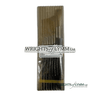Gold Leaf Across the World - Brazil
- by Sam Wozniak
Gold Leaf in Brazil: A Legacy of Shine, Spirit, and Splendor
If you’ve ever admired the luxurious shimmer of gold accents in artwork or design, chances are you’ve seen the magic of folha de ouro—gold leaf. In Brazil, this delicate material is prized for its ability to transform ordinary surfaces into something extraordinary, whether in paintings, crafts, or even culinary creations.
When we think of Brazil, we often picture vibrant colours, Baroque churches, and cultural richness. But one thread that runs through its artistic and architectural history — quite literally glowing — is gold leaf. Whether it’s 24 carat or the slightly more durable 23.5 carat variety, gold leaf has long been used to adorn the sacred, the monumental, and the luxurious across Brazil.
From the colonial gold rush to contemporary design, let’s take a journey through the gilded legacy of Brazil.
The Gold Rush that Gilded a Nation
Brazil’s golden story began in the late 17th century with a literal gold rush. Vast deposits of gold were discovered in the state of Minas Gerais, leading to a boom in wealth, population, and artistic development. It was during this time that gilding — the art of applying gold leaf to surfaces — became widespread.
The cities that emerged from this gold-fueled prosperity, especially Ouro Preto, Sabará, and Mariana, became hubs of Baroque art and architecture. Here, gold leaf wasn’t just decoration — it was a statement of faith, power, and divine beauty.
Baroque Churches and Monumental Gilding
Nowhere is Brazil’s use of gold leaf more monumental than in its Baroque churches. Stepping into the Church of São Francisco de Assis in Ouro Preto or the Church of São Francisco in Salvador, visitors are struck by walls, ceilings, and altars gleaming with intricately carved woodwork, completely covered in gold.
Most of this work used 23.5 carat gold leaf, chosen for its combination of purity and resilience — ideal for detailed, high-relief wooden carvings found in altarpieces and architectural flourishes. In some cases, especially on religious icons or smaller decorative objects, 24 carat gold leaf is applied for its intense brilliance and symbolic perfection.
For colonial Brazil, gold leaf symbolized both divine light and national prosperity. Gilded interiors weren’t just beautiful — they told a story of heaven on earth, of God’s presence in the details.
Master Artisans and the Art of Gilding
One of the most iconic figures in Brazilian gilding history is Aleijadinho (Antônio Francisco Lisboa), an 18th-century sculptor and architect. Despite a debilitating illness, he created some of the most famous works of religious art in Brazil — many of them adorned with gold leaf.
Gilding workshops thrived in the colonial period, employing skilled artisans who specialized in preparing wood, applying gold leaf, and burnishing it to a high shine. These techniques were often passed down through generations, blending Portuguese, African, and Indigenous influences into a uniquely Brazilian style.
Gilding in Brazilian Decorative Arts and Culture
Beyond religious buildings, gold leaf also found its way into furniture, religious icons, picture frames, and even sacred musical instruments. During the imperial period, aristocratic homes often featured gilded items as symbols of wealth and European sophistication.
Even today, traditional artisans in regions like Minas Gerais and Bahia continue to practice gilding, using both 23.5 and 24 carat gold leaf to restore colonial works or create new pieces inspired by the past.
Modern Uses: A New Golden Age
In contemporary Brazil, gold leaf has moved beyond church walls and into the worlds of interior design, modern art, and even gastronomy.
Brazilian artists use gold leaf to explore cultural identity, legacy, and beauty — often applying 24 carat gold to canvases, sculptures, and mixed-media works for bold visual and symbolic impact.
In architecture and interior design, gold leaf is used to add touches of glamour to walls, ceilings, and furniture, creating a sense of timeless elegance. Contemporary designers often choose 23.5 carat gold leaf for its practical balance between shine and durability.
And yes — Brazil’s high-end culinary scene has also caught the gold leaf trend. In select restaurants, especially in cities like São Paulo and Rio de Janeiro, you might just find edible 24 carat gold leaf garnishing a luxury dessert or cocktail.
Brazil’s Golden Heart Still Shines
Gold leaf in Brazil is more than a material — it’s a legacy. From the monumental churches of Minas Gerais to modern art galleries and chic dining experiences, gilding continues to represent a deep cultural connection to beauty, spirituality, and historical richness.
Whether 23.5 carat for ornate carvings or 24 carat for that unmistakable glow, gold leaf remains a powerful part of Brazil’s creative DNA — shimmering across time, space, and tradition.
The Best Places to See Gold Leaf Art in Brazil: A Cultural Overview
The use of gold leaf in Brazil is deeply embedded in the country’s artistic, religious, and architectural history. Rooted in the wealth of Brazil’s colonial era, particularly during the 18th-century gold rush, gilding became a prominent symbol of both spiritual devotion and economic power. Today, many of Brazil’s most iconic historical and artistic sites still feature spectacular examples of 23.5 carat and 24 carat gold leaf application — especially in its Baroque churches and colonial-era cities.
One of the most important regions for gold leaf art in Brazil is Minas Gerais, a south-eastern state that was at the heart of the colonial gold boom. The city of Ouro Preto (literally "Black Gold") stands out as a living testament to this gilded past. Declared a UNESCO World Heritage Site, Ouro Preto is home to some of the most lavishly gilded churches in Latin America. Among these, the Church of São Francisco de Assis is a masterpiece of Brazilian Baroque architecture and sculpture, designed by the legendary Aleijadinho (Antônio Francisco Lisboa) and featuring interiors richly adorned with carved wood coated in 23.5 carat gold leaf. The extensive use of gold in this and other churches not only demonstrated the wealth of the region but also reinforced the sacred and monumental character of these religious spaces.
Nearby cities such as Mariana and Congonhas also offer remarkable examples of colonial gilding. Mariana, the first capital of Minas Gerais, boasts several churches with intricately gilded interiors, including the Catedral da Sé and the Church of São Francisco de Assis. These structures showcase the technical skill of colonial artisans who mastered the delicate art of gilding wood, often using gold mined just miles away. In Congonhas, the Sanctuary of Bom Jesus de Matosinhos features both monumental stone sculptures and richly decorated church interiors, further highlighting the dual emphasis on sacred imagery and opulent embellishment.
In the north-eastern state of Bahia, the city of Salvador presents a different but equally rich expression of Brazil’s gilding tradition. Here, the fusion of Portuguese Baroque with Afro-Brazilian cultural influences gives rise to vibrant and expressive forms of religious art. The Church of São Francisco in Salvador is particularly famous for its overwhelming use of gold leaf. Often referred to as the "golden church," its interior is completely covered in gold-adorned woodwork, carvings, and ceiling panels. The use of 23.5 carat gold leaf in this context served both aesthetic and symbolic purposes, reflecting divine light and the power of the Church in colonial society.
Although Rio de Janeiro is primarily known for its natural beauty and modern landmarks, it too holds examples of gilded religious and artistic spaces. The Candelária Church, with its blend of Baroque and Neoclassical elements, includes ornate altars and domes decorated with gold leaf. The National Museum of Fine Arts also features gilded frames and religious artworks that reflect the imperial taste for opulence. In contemporary times, artists and designers based in Rio have also incorporated 24 carat gold leaf into their works, using it as a medium to explore themes of wealth, memory, and cultural identity.
Modern expressions of gilding can also be found in Brazil’s cultural and culinary scenes. In cities like São Paulo, high-end confectioners and chefs have begun using edible 24 carat gold leaf as a luxurious garnish for desserts and cocktails, demonstrating the continued association between gold and prestige.
In summary, Brazil offers a vast and culturally rich landscape of gold leaf artistry. From the monumental churches of Minas Gerais and Bahia to modern galleries and culinary creations, the use of 23.5 and 24 carat gold leaf continues to reflect the country's historical depth and evolving creative spirit. These gilded expressions are not just decorative — they are deeply tied to Brazil’s colonial legacy, religious traditions, and enduring artistic innovation.






